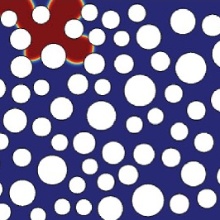We are pleased to announce the new Scientific Reports publication, published in the framework of SFB 1313 and SimTech:
Authors
- Andreas Yiotis (School of Mineral Resources Engineering, Technical University of Crete, Chania, Greece)
- Nikolaos Karadimitriou (SFB 1313 research projects B05 and C05, Institute of Mechanics (CE), University of Stuttgart, Stuttgart, Germany)
- Ioannis Zarikos (Environmental Research Laboratory, National Center for Scientific Research ’Demokritos’, Agia Paraskevi, Greece)
- Holger Steeb (SFB 1313, research projects B05 and C05 and Stuttgart Center for Simulation Technology, Institute of Mechanics (CE), University of Stuttgart, Stuttgart, Germany)
Abstract
In this work, numerical and physical experiments were carried out involving two-phase flow in an artificial, transparent porous medium, namely a micromodel. The pore structure was formed by the combination of disordered pillar-like obstacles. With the use of high s sensitivity pressure sensor at the flow inlet we were able to monitor the pressure fluctuations under fixed flux boundary conditions. We were able to capture the dynamics of the advancing interface in terms of pressure, and at the same time capture the corresponding phase distribution with optical microscopy. The experimental part of this work covered 4 orders of magnitude in terms of capillary number, as the means to depict the transition of the flow regime from a capillarity- to a viscosity-dominated one. Phenomena like Haines jumps and sequentially pore filling and simultaneous pore filling were visualized with respect to each flow regime. For the capillarity-dominated regime we were able to recover a clear correlation between the boundary pressure readout and the corresponding throat size of the invasion pressure based on Young-Laplace equation. This correlation gradually faded away, of course, as the system would transition to a viscous flow regime.
A robust Level-Set model was able to be validated experimentally by explicitly tracking the interfacial dynamic at a sub-pore scale resolution under identical flow and pore structure conditions. The numerical model was validated against well-established theoretical models which account for both effects, capillarity, and viscosity, on interfacial dynamics. The proposed numerical model recovers very well the experimentally observed flow dynamics, both in terms of phase distribution patterns and inlet pressures, but also the effects of viscous flow on the apparent (i.e. dynamic) contact angles in the vicinity of the pore walls.

Nikolaos K. Karadimitriou
Dr.Principal Investigator, Project Z02 (PML)
[Photo: Max Kovalenko]

Holger Steeb
Prof. Dr.-Ing.Spokesman, Principal Investigator, Research Projects B05, C05, and Z02, Central Project Z


